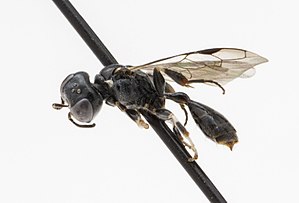Rhopalum clavipes
| Rhopalum clavipes | ||||||||||||
|---|---|---|---|---|---|---|---|---|---|---|---|---|

Rhopalum clavipes |
||||||||||||
| Systematics | ||||||||||||
|
||||||||||||
| Scientific name | ||||||||||||
| Rhopalum clavipes | ||||||||||||
| ( Linnaeus , 1758) |
Rhopalum clavipes is a hymenoptera fromthe Crabronidae family .
features
The wasp reaches a body length of 4.5 to 6.5 millimeters. The abdomen is mostly red-brown in color in the females, the pygidial field is indistinct. The males have a weakly cut out and elongated sixth antennae. The species can be confused with the males of Rhopalum coarctatum , in which the radial cell meets the wing edge at a right angle, and the thigh ( femur ) of the hind legs is three-colored yellow, black and brown. In Rhopalum clavipes the radial cell meets the wing edge at an obtuse angle.
Occurrence
The species is widespread in Central and Northern Europe and Asia, east to Japan and occurs up to an altitude of 950 meters. It colonizes different habitats, also in human settlement areas, but prefers cooler habitats. The species flies from late May to early October. It is unclear whether a second generation will be trained. It is common in Central Europe.
Way of life
The females lay their nests in stems of raspberries ( Rubus idaeus ), blackberries ( Rubus ), reeds ( Phragmites australis ), elderberries ( Sambucus ) and the like, as well as in plant galls , which are made by straw flies of the genus Liparia , Andricus kollari or the poplar buck ( Saperda populnea ). Nests have also been detected in dried coal sludge and are probably also rarely created in sand. The nests can withstand brief floods. The nest is laid out in a line shape with a diameter of 1.9 to 4.5 millimeters and consists of up to 13 cells. If there is enough space, side aisles are created with a cell at each end. The cell partition walls are made from gnawed, loosely piled pulp, but can sometimes be completely missing. Depending on the area of distribution, the brood is supplied differently. In the north, the cells are filled with six to nine dust lice (Psocoptera), in the south, flies are the main prey. Leaf fleas belonging to the Psyllidae family are also rarely caught. The females have a lifespan of around eight weeks.
supporting documents
literature
- Rolf Witt: Observe wasps, determine . 1st edition. Naturbuch-Verlag, 1998, ISBN 3-89440-243-1 .